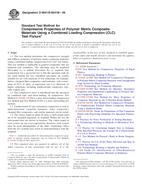Potřebujeme váš souhlas k využití jednotlivých dat, aby se vám mimo jiné mohly ukazovat informace týkající se vašich zájmů. Souhlas udělíte kliknutím na tlačítko „OK“.
ASTM D6641/D6641M-09
Standard Test Method for Compressive Properties of Polymer Matrix Composite Materials Using a Combined Loading Compression (CLC) Test Fixture
Automaticky přeložený název:
Standardní zkušební metoda pro Tlačné vlastností polymerní matrice kompozitních materiálů pomocí kombinovaném zatěžování komprese ( CLC ) zkušebního přípravku
NORMA vydána dne 15.4.2009
Informace o normě:
Označení normy: ASTM D6641/D6641M-09
Poznámka: NEPLATNÁ
Datum vydání normy: 15.4.2009
Kód zboží: NS-35993
Počet stran: 11
Přibližná hmotnost: 33 g (0.07 liber)
Země: Americká technická norma
Kategorie: Technické normy ASTM
Anotace textu normy ASTM D6641/D6641M-09 :
Keywords:
combined loading, composite materials, compressive modulus of elasticity, compressive properties, compressive strength, Poisson´s ratio, CLC (combined loading compression) device, Composites, Compression testing--composites, Polymer matrix composite materials, ICS Number Code 83.140.10 (Films and sheets)
Doplňující informace
| Significance and Use | ||||||||||||||||||||||||||||||||||||||
|
This test method is designed to produce compressive property data for material specifications, research and development, quality assurance, and structural design and analysis. When tabbed (Procedure B) specimens, typically unidirectional composites, are tested, the CLC test method (combined shear end loading) has similarities to Test Methods D 3410/D 3410M (shear loading) and D 695 (end loading). When testing lower strength materials such that untabbed CLC specimens can be used (Procedure A), the benefits of combined loading become particularly prominent. It may not be possible to successfully test untabbed specimens of these same materials using either of the other two methods. When specific laminates are tested (primarily of the [90/0]ns family, although other laminates containing at least one 0° ply can be used), the CLC data are frequently used to “back out” 0° ply strength, using lamination theory to calculate a 0° unidirectional lamina strength (1, 2). Factors that influence the compressive response include: type of material, methods of material preparation and lay-up, specimen stacking sequence, specimen preparation, specimen conditioning, environment of testing, speed of testing, time at temperature, void content, and volume percent reinforcement. Composite properties in the test direction that may be obtained from this test method include: Ultimate compressive strength, Ultimate compressive strain, Compressive (linear or chord) modulus of elasticity, and Poisson's ratio in compression. |
||||||||||||||||||||||||||||||||||||||
| 1. Scope | ||||||||||||||||||||||||||||||||||||||
|
1.1 This test method determines the compressive strength and stiffness properties of polymer matrix composite materials using a combined loading compression (CLC) (1) test fixture. This test method is applicable to general composites that are balanced and symmetric. The specimen may be untabbed (Procedure A) or tabbed (Procedure B), as required. One requirement for a successful test is that the specimen ends do not crush during the test. Untabbed specimens are usually suitable for use with materials of low orthotropy, for example, fabrics, chopped fiber composites, and laminates with a maximum of 50 % 0° plies, or equivalent (see 6.4). Materials of higher orthotropy, including unidirectional composites, typically require tabs. 1.2 The compressive force is introduced into the specimen by combined end- and shear-loading. In comparison, Test Method D 3410/D 3410M is a pure shear-loading compression test method and Test Method D 695 is a pure end-loading test method. 1.3 Unidirectional (0° ply orientation) composites as well as multi-directional composite laminates, fabric composites, chopped fiber composites, and similar materials can be tested. 1.4 The values stated in either SI units or inch-pound units are to be regarded separately as standard. Within the test the inch-pound units are shown in brackets. The values stated in each system are not exact equivalents; therefore, each system must be used independently of the other. Combining values from the two systems may result in nonconformance with the standard. Note 1—Additional procedures for determining the compressive properties of polymer matrix composites may be found in Test Methods D 3410/D 3410M, D 5467, and D 695. 1.5 This standard does not purport to address all of the safety concerns, if any, associated with its use. It is the responsibility of the user of this standard to establish appropriate safety and health practices and determine the applicability of regulatory limitations prior to use. |
||||||||||||||||||||||||||||||||||||||
| 2. Referenced Documents | ||||||||||||||||||||||||||||||||||||||
|




 Cookies
Cookies
